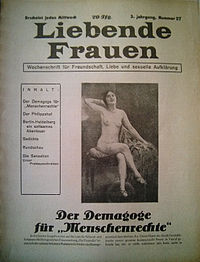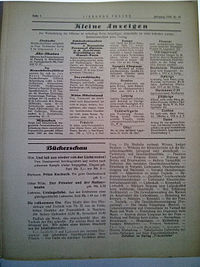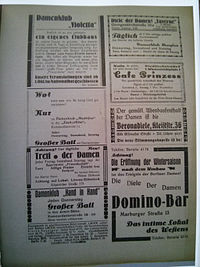Love of women
The love of women , also appeared as Women in Love and in the short term than women love and life , and later merged with the magazine Garçonne was a magazine for lesbians in the Weimar Republic , published from 1926 to 1931 in Berlin . Along with Die Freund, it was the largest and longest-running lesbian magazine of the first lesbian movement.
Publication dates and edition history
"Frauenliebe" was first published in 1926 by Karl Bergmann Verlag , Berlin. In individual editions, a Frauenliebe-Verlag is indicated as the publishing house; according to Heike Schader , however, this was not an independent publisher, but "represented a construct within the Karl-Bergmann Verlag". Karl Bergmann also headed the German Friendship Association , one of the major homosexual organizations in the Weimar Republic, so Frauenliebe also acted as the DFV's weekly publication.
The exact date of the first publication is not known, but since it was published weekly and the consecutive numbering of the year 1926 ends at 30, the first publication can be counted back to the 22nd calendar week of the year, i.e. the beginning of June 1926. As early as 1926, their circulation was given as 10,000. It was published every Wednesday and in 1928 cost 20 pfennigs. From December 15, 1930, it appeared only as an editorially independent supplement to the Garçonne , which had been published by the same publisher since October 1930 , and which explicitly understood itself as “to a certain extent the expanded and newly developed love of women […]”.
In terms of content and personnel, the "Frauenliebe" had a Berlin focus, but was also distributed nationwide.
As with many other lesbian and gay magazines, their distribution was repeatedly severely affected by their inclusion in the "List of Trash and Dirty Literature": In 1928 this led to a twelve-month ban on public notice, street sales and display in bookstores, which was ignored the journal continued to publish. The second inclusion in this list from May 1931 then led to the discontinuation of "Frauenliebe".
"Women's love", "Loving women", "Women's love and life"
The same publishing house with the same subtitle published the magazine “Liebende Frauen” from at least 1927 to 1930, which was also aimed at a lesbian audience. A connection between the two magazines was therefore considered likely for a long time. A comparative analysis of the magazines by Heike Schader then produced the surprising result in 2018 that both magazines appeared completely identical in terms of content, only with a changed title. The reasons for this approach are not known. The Spinnboden in Berlin holds numerous issues of the magazine.
In 1928 the "Frauenliebe" was classified as a dirty and trash magazine . In order to be able to circumvent the associated restrictions, it appeared temporarily under the name "Women Love and Life".
Editors and authors
Little is known about the journal's editorial responsibility. What is certain is that from 1928 until the discontinuation of “Frauenliebe” a “Karen” was the main editor.
All editorial contributions of the "Frauenliebe" were signed. Among them are well-known activists of the Berlin lesbian movement such as Selli Engler , Ruth Margarete Roellig and Annette Eick . In 1930 Prof. Karsch-Haack , Herta Laser, Annette Eick, Helga Welf, Käthe Wundram, Ikarus, Beba, Hedwig Aries, Ruth Margarete Röllig, Käte Lippert, Hildegard G. Frisch, John Mc Leen and Lo Hilmar became “permanent employees” specified.
Content
Like other lesbian magazines of the era, “Frauenliebe” was closely intertwined with local Berlin lesbian culture. She took a political stance, provided information on the subject of lesbian life in Berlin and throughout Germany, published short stories, poems and novels as well as advertisements for lesbian meeting places or private personals. There were strong connections in particular to the “Monbijou Ladies Club”, a central organization of the lesbian movement in Berlin.
In the early days the magazine contained a supplement called "Der Transvestit". After they were discontinued, the topic was regularly dealt with within the magazine.
proof
- ↑ a b c d e f g Heike Schader: "Die Zeitschrift Frauenliebe", September 13, 2018, in: Digitales Deutsches Frauenarchiv , accessed on April 16, 2019
- ^ "Preface" in: Garçonne, 1st year, 1930, No. 1
- ↑ Leidinger, Christiane: An “Illusion of Freedom” - Subculture and Organization of Lesbians, Transvestites and Gays in the Twenties [online]. Berlin 2008. In: Boxhammer, Ingeborg / Leidinger, Christiane: Online project lesbian history. , Accessed April 29, 2013
- ↑ Heike Schader: "Liebende Frauen", September 13, 2018, in: Digitales Deutsches Frauenarchiv , accessed on April 16, 2019
- ↑ Online catalog of the umbrella organization ida Individual digital copies can be called up online, e.g. 4th year No. 12








